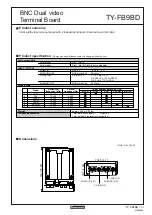
bike to be positioned at a comfortable working height. To adjust the height, swing the sleeve
assembly’s quick release lever (ref. #17) to the open position, raise the extension tube (ref. #16)
to the desired height, and swing the quick release lever to the closed position. NOTE: To avoid
personal injury and/or damage to the stand or bike, always remove the bike from the stand
before making any height adjustments.
ROTATIONAL ADJUSTMENT
The clamp of the PCS-4 can be rotated 360 degrees, allowing easy access to any component
of the bike. To adjust the rotational angle of the clamp, loosen the swing handle on the back of
the universal top tube assembly (ref. #14), rotate the clamp to the desired position, and tighten
the swing handle to lock the clamp.
CLAMPING THE BIKE
Pull the clamp handle toward you to open the clamping jaws. The clamp of the PCS-4 can be
adjusted to clamp tubes up to 1-5/8". Clamping pressure is adjusted by rotating the adjusting
barrel (ref. #9). Counter-clockwise increases the pressure, clockwise decreases the pressure.
Position the bike with the front to your right. Lift the bike with your left hand and position it in
the open jaws of the clamp. Push the clamping handle forward to clamp the bike securely. DO
NOT force the handle. Excessive clamping pressure can damage frame tubing. A good rule of
thumb is to adjust the clamp so it is possible to close it with the moderate force of two fingers.
If the clamping lever is difficult to close, or if the bike is not held securely, open the clamp and
adjust the adjusting barrel.
NOTES
Before clamping a bike in the PCS-4, clean the portion of the bike being clamped. Dirt or grit
in the clamping area may damage the finish of the bike.
The preferred clamping location on a bike is the seat tube directly below the top tube. This loca-
tion allows the bike to be easily rotated to a convenient working position. However, very thin
walled frame tubes or composite tubes should not be clamped. Clamp pressure may damage
the tube. For bikes with these types of frame tubes, the seat post should be clamped.
Some people prefer to clamp onto the top tube of the bike. The 360 degree rotation of the
clamp permits this but the bike will tend to twist toward or away from the user if it is turned
upside down.
Keeping the front of the bike slightly lower than the back when in the upright position will help
prevent the front wheel from flopping over, causing the handlebars to hit the top tube. A Park
Tool HBH-1 Handlebar Holder may also be used to prevent this.
The jaws of the clamp each have a recess to provide clearance for brake or shift cables. If it is
necessary to clamp onto a frame tube with a cable routed along the tube, make certain that the
cable is in the recess before closing the clamp. Damage to the cable or the finish of the bike
may result if the clamp surface closes on the cable.
To keep the clamp operating smoothly, occasionally apply a small amount of oil to all the pivot
points on the clamp. Do not lubricate the inside of the universal top tube assembly. Rev. 1/04




















